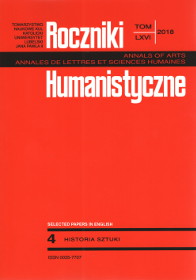The Concordia Novi Et Veteris Testamenti in its Juxtaposition of Illustrations: the Hitting of the Hammers of Tubalcain and the Hammering of the Nails into the Hands and Feet of Christ During the Crucifixione
Abstract
The Polish version of the article was published in “Roczniki Humanistyczne,” vol. 61 (2013), issue 4.
In the Gospels relating the passion of Christ, there is no description of the act of nailing Him to the cross, but there are clearly other biblical testimonies that nails were used for the crucifixion. In many representations, parallel to the nailing of the members of Christ to the cross or raising it with His body, we find placed alongside it, the scene of hammering iron with hammers by Tubal-Kain for the purpose of drawing out the appropriate tones. He hits on the anvil, while Jabal makes a notation of the tones. With this type of illustration, the sound of the hammers during the crucifixion of Christ meets with the sound of the hammers hitting the anvil. Hence, painting and music meet in the iconography of the crucifixion of Christ. It was a sort of Concordia Novi et Veteris Testamenti. In showing this prefiguration, there is also a going back to the history of Pythagoras. It was also an example for the functioning in the Middle Ages, and still later in the Renaissance, of the formulation of the Concordia divi Moysi et divini Platonis.
References
Białostocki, Jan. “Harfa Dawida i młot Tubalcaina. Miniatura Biblii Płockiej” [David’s harp and Tubalcain’s hammer. Miniature of The Płock Bible]. Biuletyn Historii Sztuki i Kultury 11, no 3–4 (1949): 169–178.
Calati, Benedetto, Gregoire Reginaldo, Blasucci Antoni. Historia duchowości [The history of spirituality], vol. IV, Duchowość średniowiecza. Translated by Konstanty Franczyk, Janusz Serafin. Kraków: Homo Dei, 2005.
Chrestomatia staropolska. Teksty do roku 1543 [Old Polish Chrestomatia. Test by 1543]. Edited by Wiesław Wydra, Wojciech R. Rzepka. Wrocław: Zakład Narodowy im. Ossolińskich, 2004.
Comestor, Petrus. Historia Scholastica Theologiae Disciplinae, Historia Libri Genesis, De generationibus Cain. Lugduni 1543.
Dawne dzieje Izraela [Old history of Israel]. Translated by Eugeniusz Dąbrowski. Poznań: Księgarnia Św. Wojciecha, 1962.
Diversarum Artium Schedula i inne średniowieczne zbiory przepisów o sztukach rozmaitych [Diversarum Artium Schedula and other medieval sets of provisions concerning different arts]. Translated and edited by Stanisław Kobielus. Kraków: Wydawnictwo Benedyktynów, 2009.
Eliade, Mircea. Kowale i alchemicy [The forge and the crucible]. Translated by Andrzej Leder. Warszawa: Aletheia, 2007.
Encyklopedia biblijna [Biblical encyclopaedia]. Edited by Paul J. Achtemeier. Warszawa: “Vocatio”–Oficyna Wydawniczo-Poligraficzna “Adam,” 2004.
Frazer, James G. Złota gałąź [The golden bough]. Translated by Henryk Krzeczkowski. Warszawa: Państwowy Instytut Wydawniczy, 1996.
Iluminacje romańskiej Biblii Płockiej [Illuminations of the Romanesque Płock Bible]. Lublin: RW KUL, 1993.
Kowalski, Piotr. Leksykon znaki świata. Omen, przesąd, znaczenie [Lexicon of the signs of the world. Omen, superstition, significance]. Warszawa: PWN, 1998.
Le Goff, Jacques. Kultura średniowiecznej Europy [Time, work and culture of the middle ages]. Translated by Hanna Szumańska-Grossowa. Warszawa: PWN, 1970.
Leclercq, Jean. Miłość nauki a pragnienie Boga [the love of learning and the desire for God]. Translated by Małgorzata Borkowska. Kraków: Wydawnictwo Benedyktynów Tyniec, 1997.
Liturgia godzin [Liturgy of the hours], vol. IV. Poznań: Wydawnictwo Pallottinum, 1988.
Lurker, Manfred. Słownik obrazów i symboli biblijnych [Dictionary of biblical images and symbols]. Translated by Kazimierz Romaniuk. Poznań: Wydawnictwo Pallottinum, 1989.
Molanus, Johannes van. Traité des saintes images, vol. II. Paris: Éd. du Cerf, 1996.
Pastoureau, Michel. Średniowieczna gra symboli [Medieval game of symbols]. Translated by Hanna Igalson-Tygielska. Warszawa: Oficyna Naukowa, 2006.
Pismo Święte Starego i Nowego Testamentu [The Scripture of the Old and New Testament]. Translated by Jakub Wujek (Vulgate). Kraków: Wydawnictwo Apostolstwa Modlitwy, 1962.
Poprzędzka, Maria. Kuźnia. Mit. Alegoria. Symbol [Smithy. Myth. Allegory. Symbol]. Warszawa: PWN, 1972.
Sancta Birgitta, Opera Minora II: Sermo Angelicus. Edited by Sten Eklund. Uppsala: Almqvist & Wiksells, 1972.
Słownik symboliki biblijnej [Dictionary of biblical symbolism]. Edited by Leland Ryken, Jim C. Wilhoit, Tremper Longman. Translated by Zbigniew Kościuk. Warszawa: “Vocatio”, 1998.
St. Bridget of Sweden Website, 1999/2000; vol. 19.
Tora. Pięcioksiąg Mojżesza [Torah. The Pentateuch]. Translated by Izaak Cylkow. Warszawa: Wydawnictwo Austeria, 2009.
Wilson-Dickson, Andrew. Historia muzyki chrześcijańskiej [The history of Christian music]. Translated by Marzena Wiśniewska. Warszawa: “Vocatio”, 2007.
Witkowska-Zaremba, Elżbieta. “Musica muris” i nurt spekulatywny w muzykologii średniowiecznej” [Musica muris and the speculative current in medieval musicology], [seria: Studia Copernicana 32]. Warszawa: Instytut Historii Nauki PAN, 1992.
Żywot Pitagorasa [The life of Pythagoras]. Translated by Janina Gajda-Krynicka. Wrocław: Epsilon, 1993.
Copyright (c) 2018 Roczniki Humanistyczne

This work is licensed under a Creative Commons Attribution-NonCommercial-NoDerivatives 4.0 International License.





